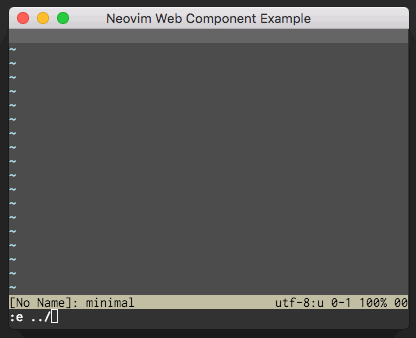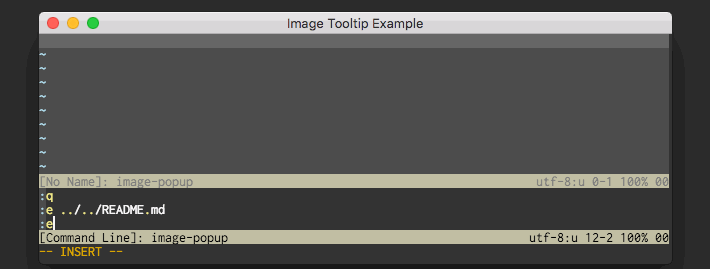This component provides <neovim-editor>, an HTML custom element built on Polymer v2
and flux. It provides a frontend for the Neovim editor
using Neovim's MessagePack API. It allows you to easily embed a Neovim-backed editor into your application.
This component assumes to be used in Node.js environment. (i.e. Electron)
You can use this component for modern desktop application frameworks such as Electron or NW.js. You can even use it in Electron-based editors such as Atom or VS Code.
This component is designed around the Flux architecture.
You can access the UI event notifications and can call Neovim APIs directly via <neovim-editor>'s
APIs.
You can install this component as an npm package.
$ npm install neovim-component
Current supported nvim version is v0.1.6 or later.
Each example only takes 100~300 lines.
<!DOCTYPE html>
<html>
<head>
<meta charset="utf-8" />
<script src="/path/to/webcomponents-lite.js"></script>
<link rel="import" href="/path/to/polymer.html" />
<link rel="import" href="/path/to/neovim-editor.html" />
</head>
<body>
<neovim-editor></neovim-editor>
</body>
</html>Minimal Electron app can be found in the example directory. This is a good start point to use this package and it shows how the component works.
How to run minimal example is:
$ git clone https://github.com/rhysd/neovim-component.git
$ cd neovim-component
$ npm startFor a more complicated and realistic example, see the markdown editor example.
The markdown previewer is integrated with the Neovim GUI using the <neovim-editor> component.
This is an image popup widget example here. The gi mapping is defined
to show an image under the cursor in a tooltip.
This example shows how to include a mini web-browser using the
<webview> tag from Electron.
Vim has very powerful editing features, but Vim is an editor (see :help design-not) and unfortunately
lacks support for many graphical tools that writers and programmers like. NyaoVim adds support for
graphical features without losing Vim's powerful text editing abilities.
Neovim's msgpack APIs provide a perfect way to add
a GUI layer using HTML and CSS. NyaoVim is a GUI frontend as
a proof of concept.
<neovim-editor> has an editor property to access the internal APIs of the component.
editor.screenis a view of the component (using canvas). It receives user input and dispatches input actions to the data store.editor.processis a process handler to interact with the backing Neovim process via msgpack-rpc APIs. You can call Neovim's APIs via the Neovim client (editor.getClient()helper).editor.storeis the state of this component. You can access the current state of the editor through this object.
You can customize <neovim-editor> with the following properties:
| Name | Description | Default |
|---|---|---|
width |
Width of the editor in pixels. | null |
height |
Height of the editor in pixels. | null |
font |
Name of the editor's monospace font. | "monospace" |
font-size |
Font-size in pixels. | 12 |
line-height |
Line height rate relative to font size. | 1.3 |
nvim-cmd |
Command used to start Neovim. | "nvim" |
argv |
Arguments passed with the Neovim command. | [] |
on-quit |
Callback function to run when Neovim quits. | null |
on-error |
Callback function for Neovim errors. | null |
disable-alt-key |
Do not send alt key input to Neovim. | false |
disable-meta-key |
Do not send meta key input to Neovim. | false |
cursor-draw-delay |
Delay in millisec before drawing cursor. | 10 |
no-blink-cursor |
Blink cursor or not. | false |
window-title |
Specify first window title. | "Neovim" |
You can receive various events (including UI redraw notifications) from the store.
The store is a part of flux architecture. It's a global instance of EventEmitter.
You can also access the state of editor via the store. Note that all values are read only.
Do not change the values of the store directly, it will break the internal state of the component.
const neovim_element = document.getElementById('neovim');
const Store = neovim_element.editor.store;
// Handle cursor movements
Store.on('cursor', () => console.log('Cursor is moved to ', Store.cursor));
// Handle mode changes
Store.on('mode', () => console.log('Mode is changed to ', Store.mode));
// Handle text redraws
Store.on('put', () => console.log('UI was redrawn'));
// Accessing the state of the editor.
const bounds = [ Store.size.lines, Store.size.cols ];
const cursor_pos = [ Store.cursor.line, Store.cursor.col ];You can call Neovim APIs via the client. When you call APIs via the client, it sends the call to the underlying Neovim process via MessagePack RPC and will return a Promise which resolves to the returned value.
<neovim-component> uses promised-neovim-client package.
You can see the all API definitions here.
If you know further about Neovim APIs, python client implementation
may be helpful.
const neovim_element = document.getElementById('neovim');
const client = neovim_element.editor.getClient();
// Send a command
client.command('vsplit');
// Send input
client.input('<C-w><C-l>');
// Evaluate a Vim script expression
client.eval('"aaa" . "bbb"').then(result => console.log(result));
// Get the 'b:foo' variable
client.getCurrentBuffer()
.then(buf => buf.getVar('foo'))
.then(v => console.log(v));
// Query something (windows, buffers, etc.)
// Move to the neighbor window and show its information.
client.getWindows()
.then(windows => client.secCurrentWindow(windows[1]))
.then(() => client.getCurrentWindow())
.then(win => console.log(win));
// Receive an RPC request from Neovim
client.on('request', (n, args, res) => console.log(`Name: ${n}, Args: ${JSON.stringify(args)}, Response: ${res}`));You can receive notifications related to lifecycle of the editor.
const neovim_element = document.getElementById('neovim');
// Called when the Neovim background process attaches
neovim_element.editor.on('process-attached', () => console.log('Neovim process is ready'));
// Called when the Neovim process is disconnected (usually by :quit)
neovim_element.editor.on('quit', () => console.log('Neovim process died'));
// Called when the <neovim-component> detaches
neovim_element.editor.on('detach', () => console.log('Element does not exist in DOM.'));
// Called upon experiencing an error in the internal process
neovim_element.editor.on('error', err => alert(err.message));- Resize screen
const editor = document.getElementById('neovim').editor;
editor.screen.resize(80, 100); // Resize screen to 80 lines and 100 columns
editor.screen.resizeWithPixels(1920, 1080); // Resize screen to 1920px x 1080px- Change font size
const editor = document.getElementById('neovim').editor;
editor.screen.changeFontSize(18); // Change font size to 18px- Convert pixels to lines/cols.
const editor = document.getElementById('neovim').editor;
const loc = editor.screen.convertPositionToLocation(80, 24);
console.log(loc.x, loc.y); // Coordinates in pixels of (line, col) = (80, 24)
const pos = editor.screen.convertLocationToPosition(400, 300);
const.log(pos.col, pos.line); // line/col of location (400px, 300px)- Notify of screen-size changes:
When some process has changed the screen-size you must notify the screen. The internal <canvas>
element has a fixed size and must update itself if there are size changes. Call screen.checkShouldResize()
if the screen size may have changed. Note that you don't need to care about resize event of <body>
element. <neovim-editor> component automatically detects this particular resize event and updates
automatically. screen.checkShouldResize() will simply be ignored if nothing has actually changed.
const editor = document.getElementById('neovim').editor;
function showUpSomeElementInNeovim() {
const e = document.getElementById('some-elem');
// New element shows up! The screen may be resized by the change.
// 'none' -> 'block'
e.style.display = 'block';
// This call tells to editor to adjust itself in the case that it has been resized
editor.screen.checkShouldResize();
}- Setting arguments afterwards:
If your app doesn't use Polymer you can set arguments afterwards using JavaScript
Note that it is better to use argv property of <neovim-element> if possible.
const editor = document.getElementById('neovim').editor;
editor.setArgv(['README.md']);- Focusing the editor
<neovim-editor> is just a web-component, so it can be focused just like other elements.
If it loses focus the editor won't receive any input events.
The editor instance has a method to re-focus the editor in JavaScript.
The store instance contains the current focus state.
const editor = document.getElementById('neovim').editor;
console.log(editor.store.focused);
editor.store.on('focus-changed', () => {
console.log('Focus was changed: ' + editor.store.focused);
});
// Refocus the editor to ensure it receives user input.
editor.focus();<neovim-component> prints logs in the browser console. The log level is controlled by the NODE_ENV
environment variable:
NODE_ENV=debugwill log everything.NODE_ENV=productionignores all logs except for warnings and errors.- Setting
NODE_ENVto empty string or some other value enables logging for info, warnings, and errors.




